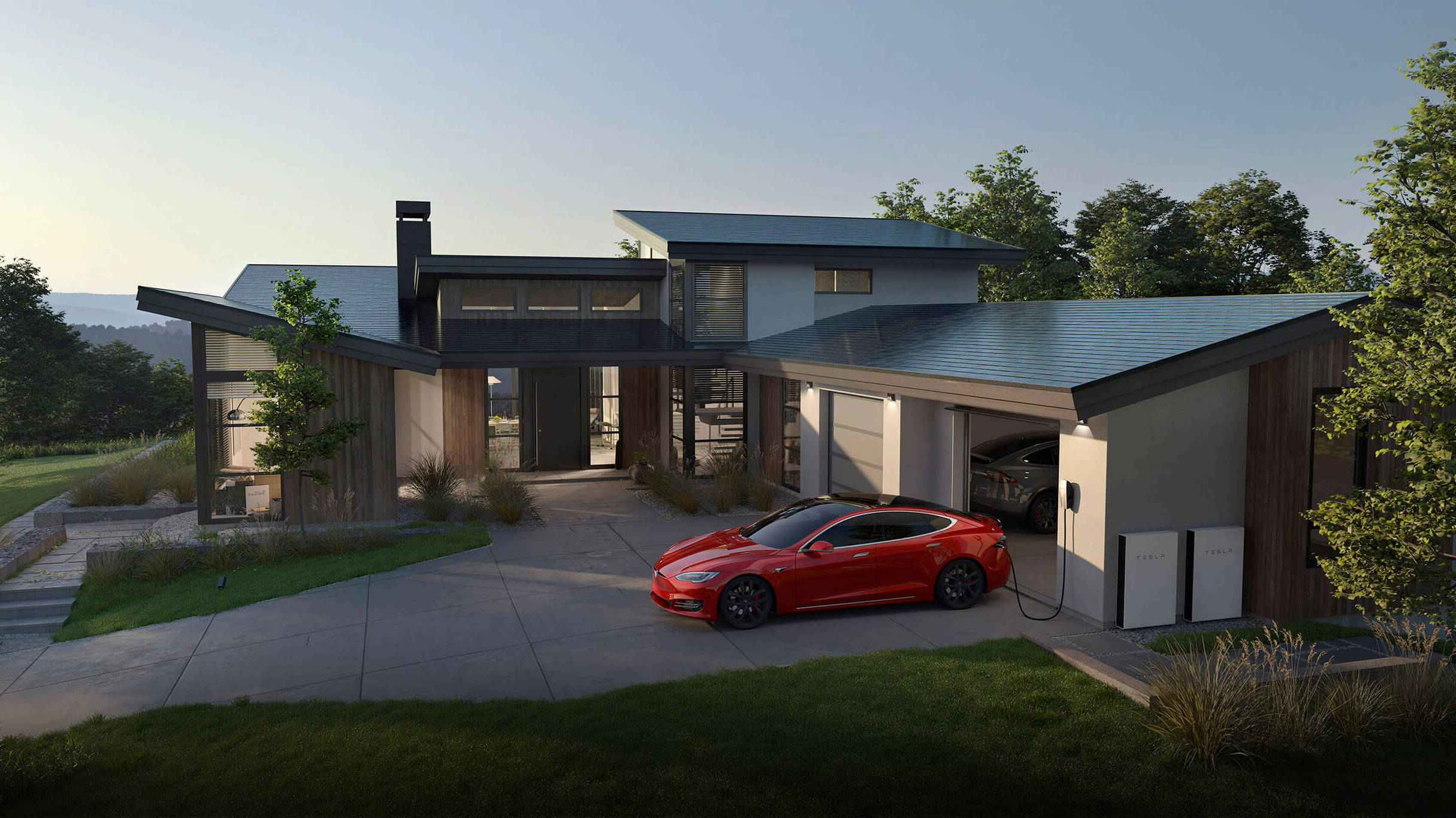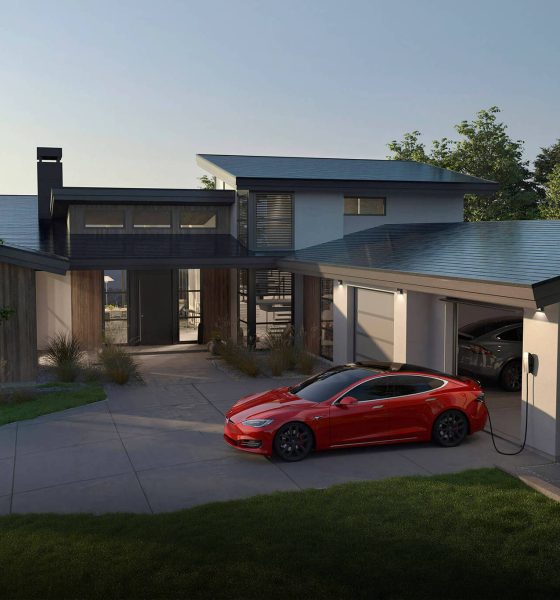

Energy
Tesla Solar Roof V3 shows a more cautious Elon Musk, and that’s a good thing
Tesla CEO Elon Musk has previously stated that 2019 will be the year of the Solar Roof, the company’s flagship solar product. This prediction almost seemed like it was forgotten for some time, until now, with the electric car maker launching its Solar Roof V3 (now named Solarglass) last Friday. Solar Roof V3 appears to be yet another sign of a change in Tesla’s CEO, one which indicates that Elon Musk has become more cautious, much to the benefit of the electric car and energy company.
The original Solar Roof tiles were unveiled in 2016 following Tesla’s acquisition of Solar City. Marketed as a more aesthetically pleasing solution for homeowners who wish to get the benefits of a photovoltaic system without committing to traditional rooftop solar panels, the Solar Roof tiles were intended by Tesla to be a revolutionary product, much like its electric vehicle line. Unfortunately, the Solar Roof saw multiple delays, and up until today, only a few installations of the rooftop system have been completed.
So notable was the delay in the Solar Roof rollout that the company’s critics actually began claiming that the product will never be produced. Reports of a Gigafactory 2 in Buffalo that was allegedly not being used to its full potential did not help the company’s narrative. Tesla, for its part, stood firm, with Elon Musk explaining that the Solar Roof tiles are taking longer than usual to release due to the product’s long development cycle. If last Friday was any indication, it appears that Elon Musk’s statements about the Solar Roof tiles were actually true, and the company was only ensuring that the shingles were fully ready before they were ramped.
Solar Roof V3 (or Solarglass, as Musk calls it), is the culmination of all the waiting and refinement that the company has performed on its flagship rooftop solar product. This time around, the solar tiles are bigger at 45″ long by 15″ wide, far larger than the 14″ long by 9″ wide tiles of the first generation producr. This larger size comes with several benefits, including lower cost of production and increased power density, and easier installation. The number of parts in the Solar Roof itself has been reduced due to the larger tiles as well, making the system less prone to potential faults.
These improvements are all centered on one concept: efficiency. While the first iteration of the Solar Roof unveiled by Tesla in 2016 was all about the tiles’ appearance, V3 is all about appearance and practicality. Since they’re larger, employees at Gigafactory 2 in Buffalo, NY will be able to manufacture them at a faster rate. Installers will also have a far easier time fitting the tiles into customers’ homes. These advantages have the potential to allow Tesla to ramp its Solar Roof V3 installations quickly.
Ultimately, these improvements to the Solar Roof would not have been made possible with a brash leader at the helm. Elon Musk is known as a CEO that is bold and prone to taking risks, yet with the Solar Roof, he appears to have adopted a far more cautious approach, something that seems to be the right decision considering the potential of the product. The Solar Roof is the solar product that will set Tesla apart from competitors, and the company would be unwise to release a version of the tiles that could not be ramped easily. After all, Tesla Energy has the potential to be a huge business for the Silicon Valley-based company, as noted by Elon Musk during the Q3 2019 earnings call.
“In the long term, I expect Tesla Energy to be of the same or roughly the same size as Tesla’s automotive sector or business. This is the most underappreciated group. I think it could be bigger, but it’s certainly of a similar magnitude to Tesla Solar. Meaning, if you take Tesla Solar plus battery stuff, Tesla Energy is, I think, the least appreciated element,” Musk said.

Cybertruck
Tesla updates Cybertruck owners about key Powershare feature

Tesla is updating Cybertruck owners on its timeline of a massive feature that has yet to ship: Powershare with Powerwall.
Powershare is a bidirectional charging feature exclusive to Cybertruck, which allows the vehicle’s battery to act as a portable power source for homes, appliances, tools, other EVs, and more. It was announced in late 2023 as part of Tesla’s push into vehicle-to-everything energy sharing, and acting as a giant portable charger is the main advantage, as it can provide backup power during outages.
Cybertruck’s Powershare system supports both vehicle-to-load (V2L) and vehicle-to-home (V2H), making it flexible and well-rounded for a variety of applications.
However, even though the feature was promised with Cybertruck, it has yet to be shipped to vehicles. Tesla communicated with owners through email recently regarding Powershare with Powerwall, which essentially has the pickup act as an extended battery.
Powerwall discharge would be prioritized before tapping into the truck’s larger pack.
However, Tesla is still working on getting the feature out to owners, an email said:
“We’re writing to let you know that the Powershare with Powerwall feature is still in development and is now scheduled for release in mid-2026.
This new release date gives us additional time to design and test this feature, ensuring its ability to communicate and optimize energy sharing between your vehicle and many configurations and generations of Powerwall. We are also using this time to develop additional Powershare features that will help us continue to accelerate the world’s transition to sustainable energy.”
Owners have expressed some real disappointment in Tesla’s continuous delays in releasing the feature, as it was expected to be released by late 2024, but now has been pushed back several times to mid-2026, according to the email.
Foundation Series Cybertruck buyers paid extra, expecting the feature to be rolled out with their vehicle upon pickup.
Cybertruck’s Lead Engineer, Wes Morrill, even commented on the holdup:
As a Cybertruck owner who also has Powerwall, I empathize with the disappointed comments.
To their credit, the team has delivered powershare functionality to Cybertruck customers who otherwise have no backup with development of the powershare gateway. As well as those with solar…
— Wes (@wmorrill3) December 12, 2025
He said that “it turned out to be much harder than anticipated to make powershare work seamlessly with existing Powerwalls through existing wall connectors. Two grid-forming devices need to negotiate who will form and who will follow, depending on the state of charge of each, and they need to do this without a network and through multiple generations of hardware, and test and validate this process through rigorous certifications to ensure grid safety.”
It’s nice to see the transparency, but it is justified for some Cybertruck owners to feel like they’ve been bait-and-switched.
Energy
Tesla starts hiring efforts for Texas Megafactory
Tesla’s Brookshire site is expected to produce 10,000 Megapacks annually, equal to 40 gigawatt hours of energy storage.

Tesla has officially begun hiring for its new $200 million Megafactory in Brookshire, Texas, a manufacturing hub expected to employ 1,500 people by 2028. The facility, which will build Tesla’s grid-scale Megapack batteries, is part of the company’s growing energy storage footprint.
Tesla’s hiring efforts for the Texas Megafactory are hinted at by the job openings currently active on the company’s Careers website.
Tesla’s Texas Megafactory
Tesla’s Brookshire site is expected to produce 10,000 Megapacks annually, equal to 40 gigawatt hours of energy storage, similar to the Lathrop Megafactory in California. Tesla’s Careers website currently lists over 30 job openings for the site, from engineers, welders, and project managers. Each of the openings is listed for Brookshire, Texas.
The company has leased two buildings in Empire West Business Park, with over $194 million in combined property and equipment investment. Tesla’s agreement with Waller County includes a 60% property tax abatement, contingent on meeting employment benchmarks: 375 jobs by 2026, 750 by 2027, and 1,500 by 2028, as noted in a report from the Houston Business Journal. Tesla is required to employ at least 1,500 workers in the facility through the rest of the 10-year abatement period.
Tesla’s clean energy boom
City officials have stated that Tesla’s arrival marks a turning point for the Texas city, as it highlights a shift from logistics to advanced clean energy manufacturing. Ramiro Bautista from Brookshire’s economic development office, highlighted this in a comment to the Journal.
“(Tesla) has great-paying jobs. Not just that, but the advanced manufacturing (and) clean energy is coming to the area,” he said. “So it’s not just your normal logistics manufacturing. This is advanced manufacturing coming to this area, and this brings a different type of job and investment into the local economy.”
Energy
Tesla and Samsung SDI in talks over new US battery storage deal: report
The update was related by industry sources and initially reported by South Korean news outlets.

Recent reports have suggested that Tesla and Samsung SDI are in talks over a potential partnership to supply batteries for large-scale energy storage systems (ESS).
The update was related by industry sources and initially reported by South Korean news outlets.
ESS batteries to be built at Samsung’s Indiana plant
As noted in a report from Korea JoongAng Daily, the demand for energy storage systems has been growing rapidly in North America, thanks in no small part to the surge in AI investments across numerous companies. With this in mind, Tesla has reportedly approached Samsung SDI about a potential battery supply deal.
The deal is reportedly worth over 3 trillion Korean won (approximately $2.11 billion) and will span three years, according to The Korea Global Economic Daily. A battery supply deal with Samsung SDI could make sense for Tesla as the company already has a grid-scale battery, the Megapack, which is perfect for industrial use. Samsung SDI could simply supply cells for the EV maker.
Production of the batteries would reportedly take place at Samsung SDI’s joint venture factory with Stellantis in Indiana, which is currently under construction. Samsung SDI recently announced plans to use part of that plant’s EV lines to produce cells for ESS, with a targeted capacity of 30 GWh by the end of next year.
Tesla and Samsung’s partnership
At present, only a handful of manufacturers, including Korea’s LG Energy Solution, Samsung SDI, SK On, and Japan’s Panasonic, are capable of producing energy storage-scale batteries domestically in the United States. A Samsung SDI official issued a comment about the matter, stating, “Nothing has been finalized regarding cooperation with Tesla.”
The possible energy storage system deal adds another layer to Tesla’s growing collaboration with Samsung, which is already in line as a partner in the upcoming production of Tesla’s AI5 and AI6 chips. Early sample manufacturing of the AI6 is expected to begin in South Korea, with mass production slated for Samsung’s Texas-based Taylor foundry when it starts operations.
The AI6 chip will power Tesla’s next wave of high-volume projects, including the Optimus humanoid robot and the autonomous Cybercab service. Musk has called the partnership with Samsung a “real collaboration,” adding that he personally plans to “walk the line” at the Taylor facility to speed up progress.








